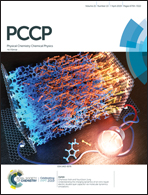Single-particle correlation study: chemical interface damping induced by biotinylated proteins with sulfur in plasmonic gold nanorods†
Abstract
Plasmonic gold nanoparticles can be an efficient source of hot electrons that can transfer to adsorbed molecules for photochemistry, followed by broadening of the homogeneous localized surface plasmon resonance (LSPR) linewidth. Although chemical interface damping (CID) is one of the main decay processes, it is the most poorly understood damping mechanism in gold nanoparticles. Herein, to better understand CID and to find new functional groups that can induce CID as an alternative to thiol groups (–SH, sulfhydryl groups), we carried out scanning electron microscopy (SEM) correlated dark-field (DF) scattering studies of gold nanorods (AuNRs) at the single-particle level. We found that biotin with sulfur can lead to strong plasmon damping in single AuNRs. We chose biotin in this study because it is widely used as a linker that can selectively bind to streptavidin in many biological sensing experiments. We further demonstrated the possibility of real-time detection of biological molecules, specifically biotinylated BSA proteins, by means of CID in single AuNRs. Therefore, this study allows us to gain a deeper insight into how adsorbate molecules with sulfur affect CID, which is an important step toward developing a CID-based LSPR biosensor to detect real biological molecules having sulfur or thiol groups without interference from the medium dielectric constant in single AuNRs.



 Please wait while we load your content...
Please wait while we load your content...